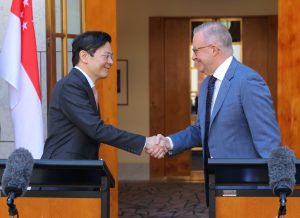Singapore and Australia have agreed to enhance their defense relationship, including by granting enhanced reciprocal access to naval and air bases in both countries. The announcement was made by Singapore’s Prime Minister Lawrence Wong during a state visit to Australia, his first since taking office last year, during which he met with Prime Minister Anthony Albanese and other senior Australian officials.
“We already have a strong defense partnership, but we are enhancing it further and providing more support and enhanced access to Singapore’s air and naval bases,” Wong said during a joint press conference in Canberra. He added that the arrangement would “enable Australia to deploy more of its forces in our part of the world” and would “mean stronger facilitation for Australia to participate in Asia.”
Albanese said that the “enhanced availability of Singapore’s ports and air access” was vital for Australia to increase its presence in Southeast Asia and was “a logical next step” in the longstanding defense partnership between the two nations. According to a statement by the Singaporean Defense Ministry, the agreement will also involve improved Singaporean access to Australian military facilities.
Exactly what this enhanced access will look like remains unclear – Wong said that many of the details were still to be worked out – but this was just one part of an MoU on Enhanced Defense Cooperation that was signed during the Singaporean leader’s visit.
Under this agreement, which was signed on Tuesday by Singapore’s Defense Minister Chan Chun Sing and his Australian counterpart Richard Marles, both countries have also agreed to “step up cooperation in defense science and technology, logistics, and supply chains, and expand professional exchanges between both militaries.”
The defense upgrade is part of what Albanese and Wong described as an “upgraded Comprehensive Strategic Partnership,” which coincides with both the 60th anniversary of diplomatic relations between the two nations and the 1oth anniversary of their 2015 Comprehensive Strategic Partnership.
Albanese said that this CSP 2.0 was designed to take the bilateral relationship “to the next level.” In addition to the MoU on Enhanced Defense Cooperation, this will involve an expanded economic partnership and collaborations on climate change action, pandemic preparedness, and artificial intelligence, he said. It will also include more substantial partnerships “between our public service, universities, and art institutions.”
The proposed defense agreement builds on a substantial bilateral partnership between the two nations’ militaries. For years, the Singapore Armed Forces have conducted training in Australia, both on their own and bilaterally with the Australian Defense Force. In 2020, the two nations signed a military training initiative designed to expand Singapore’s access to training facilities in Queensland, including the Shoalwater Bay Training Area north of Rockhampton. Under the terms of the Australia-Singapore Military Training Initiative, “up to 14,000 Singapore Armed Forces personnel will conduct unilateral training [in Australia] for up to 18 weeks a year for 25 years.”
This comes on top of the series of bilateral and multilateral annual training exercises that the Singapore and Australian militaries already conduct with each year and other close partners, including the United States.
Further strengthening this defense cooperation between the two nations makes a great deal of sense in light of the uncertain direction of U.S. foreign policy. Both Singapore and Australia have been strong supporters of a continued strong U.S. security presence in Asia, but as this grows increasingly uncertain – the Trump administration’s draft National Defense Strategy reportedly prioritizes protecting the U.S. homeland and the western hemisphere over countering China – it is only logical that the two countries would seek to cooperate more closely with one another.





























